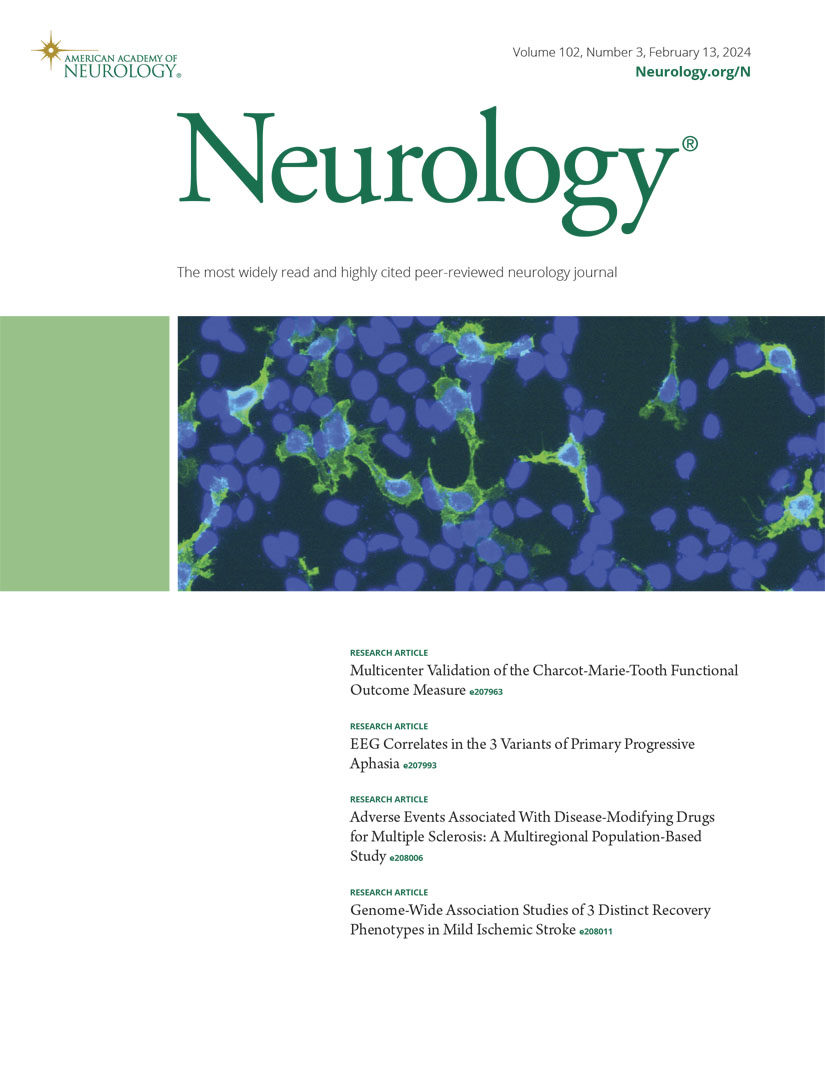Persistent Postictal Central Apnea in Focal Seizures: Incidence, Features, and Imaging Findings.
IF 7.7
1区 医学
Q1 CLINICAL NEUROLOGY
引用次数: 0
Abstract
BACKGROUND AND OBJECTIVES Postconvulsive central apnea has emerged as a contributor to sudden unexplained death in epilepsy. The aim of this study was to evaluate the incidence and characteristics of postictal central apnea (PICA) in focal seizures. The secondary aim was to analyze morphometric features of the amygdala and other subcortical structures involved in autonomic control. METHODS We prospectively enrolled consecutive patients admitted to the Epilepsy Monitoring Unit at Modena Academic Hospital (Italy) from April 2020 to December 2023. Inclusion criteria were as follows: (1) age older than 13 years; (2) at least 1 focal-onset seizure recorded during long-term video-EEG monitoring (LTVEM) with cardiorespiratory polygraphy. For each seizure, the presence of ictal central apnea (ICA) and/or PICA and its features were evaluated. Amygdala, hippocampus, thalamus, brainstem, and cerebellum volumetry were compared in patients with ICA/PICA with respect to healthy controls and patients with focal seizures without peri-ictal breathing disorders. RESULTS A total of 69 patients (mean age 35.7 years; 42% female) with 406 focal-onset seizures were analyzed. ICA was recorded in 71 seizures (17%) in 27 patients. PICA was recorded in 24 seizures in 12 patients (10 with temporal lobe epilepsy) corresponding to 5.9% of all recorded seizures. Notably, PICA was observed only in seizures showing ictal apnea (in 33.8%). In 11 seizures with PICA, a single apneic event starting in the ictal and extending to the postictal period was observed. In 13 seizures, multiple apneic events were present in the postictal period (range 2-8). Seizures with PICA showed a longer peri-ictal apnea time (mean 75 seconds vs 40 seconds; p = 0.007) and a longer time to restore a regular rhythmic breathing after seizure termination (mean 173 seconds vs 42 seconds; p < 0.001) than seizures with self-limiting ictal apnea. Amygdala volumes ipsilateral to the epileptogenic zone were larger in patients with ICA/PICA compared with controls and patients without seizure-related apnea. DISCUSSION PICA occurs in approximately 6% of focal seizures and is associated with extended apnea time and an enlarged amygdala ipsilaterally to the epileptogenic zone. Our data support the existence of a continuum from ictal to PICA and highlight the importance of cardiorespiratory recordings in LTVEM.局灶性癫痫发作后持续性中枢性呼吸暂停:发病率、特征和影像学表现。
背景与目的惊厥后中枢性呼吸暂停已成为癫痫患者猝死的原因之一。本研究的目的是评估局灶性癫痫发作后中枢性呼吸暂停(PICA)的发生率和特征。第二个目的是分析杏仁核和其他参与自主神经控制的皮层下结构的形态特征。方法前瞻性纳入2020年4月至2023年12月在意大利摩德纳学术医院癫痫监测部门连续收治的患者。纳入标准如下:(1)年龄大于13岁;(2)心肺测谎术长期视频脑电图监测(LTVEM)记录至少1次局灶性癫痫发作。对于每次发作,评估发作性中枢性呼吸暂停(ICA)和/或PICA的存在及其特征。将ICA/PICA患者的杏仁核、海马体、丘脑、脑干和小脑体积测量与健康对照和无围周呼吸障碍的局灶性癫痫患者进行比较。结果共69例患者,平均年龄35.7岁;42%为女性),406例局灶性癫痫发作。27例患者中有71例癫痫发作(17%)发生ICA。12例患者24次癫痫发作中出现异食异食(10例为颞叶癫痫),占所有癫痫发作记录的5.9%。值得注意的是,异食癖仅在癫痫发作时出现发作性呼吸暂停(33.8%)。在11例异食癖癫痫发作中,观察到从发作初期开始并延伸到发作后期的单一窒息事件。在13例癫痫发作中,多发窒息事件出现在发作后时期(范围2-8)。异食癖发作时围周呼吸暂停时间较长(平均75秒vs 40秒;P = 0.007),癫痫发作结束后恢复正常节律呼吸所需时间更长(平均173秒vs 42秒;P < 0.001),高于自限性发作性呼吸暂停。与对照组和无癫痫相关呼吸暂停的患者相比,ICA/PICA患者癫痫区同侧的杏仁核体积更大。异食癖发生于约6%的局灶性癫痫发作,与呼吸暂停时间延长和癫痫区同侧杏仁核增大有关。我们的数据支持从危重症到异食症的连续性存在,并强调了LTVEM中心肺记录的重要性。
本文章由计算机程序翻译,如有差异,请以英文原文为准。
求助全文
约1分钟内获得全文
求助全文
来源期刊

Neurology
医学-临床神经学
CiteScore
12.20
自引率
4.00%
发文量
1973
审稿时长
2-3 weeks
期刊介绍:
Neurology, the official journal of the American Academy of Neurology, aspires to be the premier peer-reviewed journal for clinical neurology research. Its mission is to publish exceptional peer-reviewed original research articles, editorials, and reviews to improve patient care, education, clinical research, and professionalism in neurology.
As the leading clinical neurology journal worldwide, Neurology targets physicians specializing in nervous system diseases and conditions. It aims to advance the field by presenting new basic and clinical research that influences neurological practice. The journal is a leading source of cutting-edge, peer-reviewed information for the neurology community worldwide. Editorial content includes Research, Clinical/Scientific Notes, Views, Historical Neurology, NeuroImages, Humanities, Letters, and position papers from the American Academy of Neurology. The online version is considered the definitive version, encompassing all available content.
Neurology is indexed in prestigious databases such as MEDLINE/PubMed, Embase, Scopus, Biological Abstracts®, PsycINFO®, Current Contents®, Web of Science®, CrossRef, and Google Scholar.
 求助内容:
求助内容: 应助结果提醒方式:
应助结果提醒方式:


